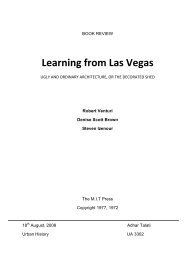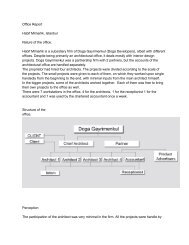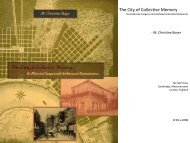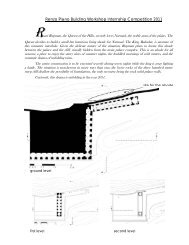Influence of millowners on Ahmedabads planning
Influence of millowners on Ahmedabads planning
Influence of millowners on Ahmedabads planning
Create successful ePaper yourself
Turn your PDF publications into a flip-book with our unique Google optimized e-Paper software.
City Reader : Rise and <str<strong>on</strong>g>Influence</str<strong>on</strong>g> <str<strong>on</strong>g>of</str<strong>on</strong>g> Millowners <strong>on</strong> the Planning <str<strong>on</strong>g>of</str<strong>on</strong>g> Ahmedabad 2<br />
protests against the government's various interventi<strong>on</strong>ist measures. In 1917, Vallabhbhai Patel,<br />
the foremost leader <str<strong>on</strong>g>of</str<strong>on</strong>g> this group was elected to the Municipal Board. Vallabhbhai's group tried<br />
to c<strong>on</strong>solidate their positi<strong>on</strong> in the Municipality and in the city in a variety <str<strong>on</strong>g>of</str<strong>on</strong>g> ways. Firstly, they<br />
tried to achieve this by removing from <str<strong>on</strong>g>of</str<strong>on</strong>g>fice certain abrasive and arrogant government <str<strong>on</strong>g>of</str<strong>on</strong>g>ficials<br />
who then still dominated the municipal administrati<strong>on</strong>. At the same time the new elite leaders<br />
tried to broaden their political base through the extensi<strong>on</strong> <str<strong>on</strong>g>of</str<strong>on</strong>g> municipal franchise in the city.<br />
Vallabhbhai's group tried to ensure that the social groups which would tend to support their<br />
efforts in the Municipality and to whose ranks most <str<strong>on</strong>g>of</str<strong>on</strong>g> their members bel<strong>on</strong>ged secured more<br />
representati<strong>on</strong> <strong>on</strong> the Municipal Board. However, in extending the franchise the new political<br />
elites were careful to keep the expanded franchise restricted to the property-holding, tax and<br />
rent-paying secti<strong>on</strong>s and the salaried middle classes in the urban society.<br />
The sec<strong>on</strong>d way in which Vallabhbhai's group tried to strengthen their positi<strong>on</strong> was by forging<br />
alliances with the leaders <str<strong>on</strong>g>of</str<strong>on</strong>g> the different ec<strong>on</strong>omic interests in Ahmedabad. Vallabhbhai's group<br />
also looked for allies in the local communities <str<strong>on</strong>g>of</str<strong>on</strong>g> the pols. By 1918, a large number <str<strong>on</strong>g>of</str<strong>on</strong>g> members<br />
and supporters <str<strong>on</strong>g>of</str<strong>on</strong>g> Vallabhbhai's group had been elected to the different municipal Committees. 3<br />
Significantly, most <str<strong>on</strong>g>of</str<strong>on</strong>g> these men were either members <str<strong>on</strong>g>of</str<strong>on</strong>g> the emerging industrial bourgeoisie or<br />
were prominent lawyers, doctors, school teachers and other pr<str<strong>on</strong>g>of</str<strong>on</strong>g>essi<strong>on</strong>als <str<strong>on</strong>g>of</str<strong>on</strong>g> the city. 3 C<strong>on</strong>trol<br />
over these various municipal committees helped Vallabhbhai's group to intervene in different<br />
spheres <str<strong>on</strong>g>of</str<strong>on</strong>g> the city's life very effectively at a later stage.<br />
The Reorganizati<strong>on</strong> <str<strong>on</strong>g>of</str<strong>on</strong>g> Ahmedabad City by the Indian Elite Leaders<br />
Once the city leaders assumed c<strong>on</strong>trol <str<strong>on</strong>g>of</str<strong>on</strong>g> the Municipality, they started to use the infrastructural<br />
facilities provided by that instituti<strong>on</strong> to bring about a transformati<strong>on</strong> <str<strong>on</strong>g>of</str<strong>on</strong>g> Ahmedabad city. They<br />
were attempting to establish a new political, social and cultural order in Ahmedabad.<br />
1920s<br />
One <str<strong>on</strong>g>of</str<strong>on</strong>g> the first steps the elite leaders took was the restructuring and opening up <str<strong>on</strong>g>of</str<strong>on</strong>g> Pols in order<br />
to 'relieve' the c<strong>on</strong>gesti<strong>on</strong> in the urban centre. Plans were formulated for the acquiring houses,<br />
kotdas, walls and medas in the various streets and pols inside the city, so that two or more streets<br />
could be c<strong>on</strong>nected and plots opened up as air spaces to provide light and ventilati<strong>on</strong>. 3<br />
Then they turned their attenti<strong>on</strong> towards the lands outside the city walls.<br />
Jamalpur Scheme<br />
In 1918, a scheme was proposed to reorganize according to the new spatial order a piece <str<strong>on</strong>g>of</str<strong>on</strong>g> land,<br />
to the south <str<strong>on</strong>g>of</str<strong>on</strong>g> the city wall between the Jamalpur and Astodia Gates. In April 1920, the<br />
Municipal Board decided to impose a land tax <str<strong>on</strong>g>of</str<strong>on</strong>g> two per cent <strong>on</strong> the situati<strong>on</strong> value <strong>on</strong> 'open'<br />
lands, situated <strong>on</strong> the outskirts <str<strong>on</strong>g>of</str<strong>on</strong>g> the city, so as to bring those lands to n<strong>on</strong>-agricultural use by<br />
the people from the city.<br />
Urban History VI Rahul Raina 2404
















